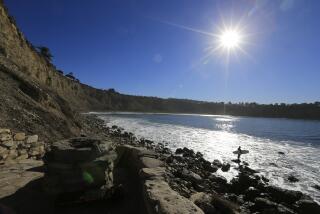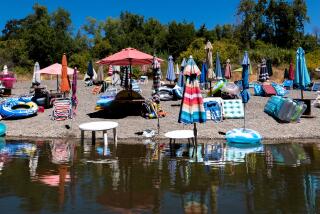Wave-Riding Rivalry Builds Over Contest
- Share via
NEWPORT BEACH — Scott Sailer is tired of bodyboarders gettin’ dissed.
In Sailer’s world, the ranks of body boarders who zip across ocean waves aboard a polyethylene foil may be growing, but it’s the surfboarders who get all the attention.
“The problem,” said Sailer, a 25-year-old Golden West College student who lives in Huntington Beach, “is that in and out of the water we’ve been treated as a redheaded stepchild.”
He’s been trying to change that, but has met sometimes bitter resistance.
Sailer, eager to combat what he sees as a publicity problem for the estimated 2 million bodyboarders in the United States, seeks to coordinate the first bodyboarding competition held at the famed Wedge in Newport Beach.
However, what sounded good in October, when he began his project, has become dicey after Sailer encountered the Wedge Preservation Society, a loosely organized group of about 100 bodysurfers who Sailer contends virtually “own” the Wedge.
Although Sailer has asked local residents for support and gone to the city’s recreation, police and lifeguard departments, which are reviewing his permit to hold a special event, he said dealing with the Wedge society is standing in the way of the competition.
“They have a blackball situation where they get the Wedge for seven hours a day during the peak season and they’re still complaining,” Sailer said.
The society doesn’t see itself as the problem.
“The Wedge has been exploited enough,” said Kevin “Mel” Thoman, 39, who has bodysurfed the famed spot for at least two decades and whose passion for the break created the Wedge society.
Thoman contends a bodyboarding competition would bring commercialism to the Wedge.
“We don’t believe in contests for ourselves,” he said. “In fact, there’s never really been a contest for anything at the Wedge. To us, bodysurfing there is more of an art form than anything else.
“We don’t need a ton of geek bodyboarders,” said Thoman, who bluntly described his water adversaries as “all young, very brash [individuals] who want only to get a picture of themselves in the bodyboarding magazines.”
In 1993, the society initiated a “blackball” ban prohibiting anyone using flotation devices--such as bodyboards--from entering the water from 10 a.m. to 5 p.m., May 1 to Oct. 31. Violators receive citations from lifeguards.
The unusual ban is one of the few on California’s coastline that allows only bodysurfers to enjoy the Wedge during peak hours in the summer, when the famed beach break comes alive.
Located at the tip of the Balboa Peninsula, the Wedge produces some of California’s premier waves, known for their steep drop and high speed. During a good summer, powerful south swells bounce off a rock jetty, creating waves 20 feet high or larger. It’s a Southern California attraction that draws hundreds of spectators who “ooh” and “aah” while fearless athletes go after “Big Wedge,” as it’s called.
It’s also a natural arena for top talent. But with only one main peak, it gets crowded with bodyboarders, bodysurfers, knee boarders, skim boarders and surfers competing for the same wave.
Arguments are frequent, sometimes ending in punch-outs, and the city enacted the ban in part to help ease the tension.
Newport Beach lifeguard Gordon Reed said that although there are a lot more bodyboarders than bodysurfers, “there’s a lot of happy bodysurfers and disgruntled bodyboarders.”
The city’s practice is to have the applicant for special events garner support of the people affected the most, said David McConnell, Newport Beach recreation manager. This means that Sailer must negotiate a truce with the bodysurfers and homeowners’ groups before his permit is decided by the City Council at its Feb. 24 meeting.
Sailer said that he obtained the society’s support for his contest, but it was later rescinded.
“The Wedge preservation group did give its support in a letter to the city,” McConnell said. “Scott’s beef is why did they send the first letter if only to pull their support later?”
Thoman explained that Sailer only spoke to one of three of the society’s leaders. When word spread that a contest, let alone a bodyboarding contest, was proposed at the Wedge, the other two leaders squawked, Thoman said.
Many bodyboarding manufacturing companies have thought of holding a Wedge contest, including Morey Bodyboards in El Segundo, one of the largest producers of soft boards, ever since Tom Morey of San Clemente invented a progressive shape in 1971.
“Our understanding,” said J.P. Patterson, Morey’s promotional manager, “is that the problem was more of a logistic thing. The site has no parking, no toilets, no infrastructure such as scaffolding and, also this war between the bodysurfers and bodyboarders made it even more difficult.”
Yet, Patterson and other industry people admit they would love the Wedge as a contest venue because of its potential to produce a wave that rivals Hawaii’s Pipeline. In fact, professional bodyboarders such as world champion Mike Stewart and others recently competed in a Pipeline contest where 18-foot waves provided an aquatic showplace.
“Among bodyboarders,” said Eric Fairbanks, editor of Bodyboarding magazine published in San Clemente, “there is such an underlying passion that the wave at the Wedge produces. If this were Huntington Beach, no one would care. It’s the Wedge. And, a contest there would be fantastic.”
Sailer said he has offered to hold a bodysurfing exhibition during the proposed contest to placate society members.
“I got insurance, I’ve met with building and parks department,” Sailer said. “I’ve talked to police about the parking and crowd control. I’ve got security for the event, and a sanitation company to bring in portable toilets. And, Hoag hospital’s Project Wipeout has donated a shuttle service from their parking lot. You know, this was to try and build a bridge between the bodysurfers and bodyboarders.”
Thoman wants none of it. He recalled the old days when it was just a few hard-core bodysurfers who challenged the Wedge, before the bodyboarding revolution. Thoman said it takes years to become proficient at such a dangerous break.
In fact, he said that many bodysurfers are much older than their bodyboarding counterparts, some in their 50s, and generational differences only fuel the bitter rivalry.
“You have only a handful of guys, bodysurfing the place the way it should be surfed. Look at me and my age,” said Thoman, who turns 40 in two weeks. “Bodysurfing is a sport getting trampled and pushed out of the way.”


